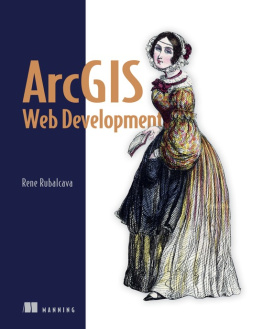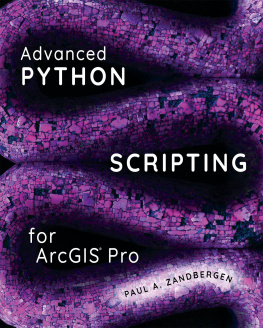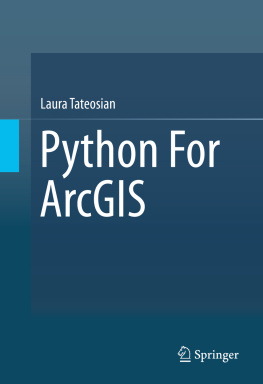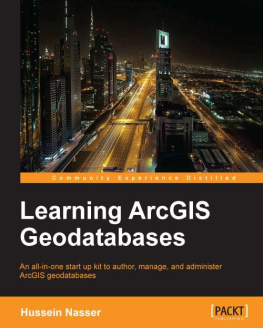Rene Rubalcava - ArcGIS Web Development
Here you can read online Rene Rubalcava - ArcGIS Web Development full text of the book (entire story) in english for free. Download pdf and epub, get meaning, cover and reviews about this ebook. year: 2015, publisher: Manning, genre: Computer. Description of the work, (preface) as well as reviews are available. Best literature library LitArk.com created for fans of good reading and offers a wide selection of genres:
Romance novel
Science fiction
Adventure
Detective
Science
History
Home and family
Prose
Art
Politics
Computer
Non-fiction
Religion
Business
Children
Humor
Choose a favorite category and find really read worthwhile books. Enjoy immersion in the world of imagination, feel the emotions of the characters or learn something new for yourself, make an fascinating discovery.
- Book:ArcGIS Web Development
- Author:
- Publisher:Manning
- Genre:
- Year:2015
- Rating:5 / 5
- Favourites:Add to favourites
- Your mark:
- 100
- 1
- 2
- 3
- 4
- 5
ArcGIS Web Development: summary, description and annotation
We offer to read an annotation, description, summary or preface (depends on what the author of the book "ArcGIS Web Development" wrote himself). If you haven't found the necessary information about the book — write in the comments, we will try to find it.
ArcGIS Web Development — read online for free the complete book (whole text) full work
Below is the text of the book, divided by pages. System saving the place of the last page read, allows you to conveniently read the book "ArcGIS Web Development" online for free, without having to search again every time where you left off. Put a bookmark, and you can go to the page where you finished reading at any time.
Font size:
Interval:
Bookmark:

For online information and ordering of this and other Manning books, please visit www.manning.com. The publisher offers discounts on this book when ordered in quantity. For more information, please contact
Special Sales Department Manning Publications Co. 20 Baldwin Road PO Box 261 Shelter Island, NY 11964 Email: orders@manning.com2015 by Manning Publications Co. All rights reserved.
No part of this publication may be reproduced, stored in a retrieval system, or transmitted, in any form or by means electronic, mechanical, photocopying, or otherwise, without prior written permission of the publisher.
Many of the designations used by manufacturers and sellers to distinguish their products are claimed as trademarks. Where those designations appear in the book, and Manning Publications was aware of a trademark claim, the designations have been printed in initial caps or all caps.
 Recognizing the importance of preserving what has been written, it is Mannings policy to have the books we publish printed on acid-free paper, and we exert our best efforts to that end. Recognizing also our responsibility to conserve the resources of our planet, Manning books are printed on paper that is at least 15 percent recycled and processed without elemental chlorine.
Recognizing the importance of preserving what has been written, it is Mannings policy to have the books we publish printed on acid-free paper, and we exert our best efforts to that end. Recognizing also our responsibility to conserve the resources of our planet, Manning books are printed on paper that is at least 15 percent recycled and processed without elemental chlorine.
 | Manning Publications Co.20 Baldwin RoadPO Box 261Shelter Island, NY 11964 | Development editor: Susan ConantTechnical development editor: Florian LengyelTechnical proofreader: Brian ArnoldCopyeditors: Lianna Wlasiuk,Katie PetitoProofreader: Melody DolabTypesetter: Marija TudorCover designer: Marija Tudor |
ISBN: 9781617291616
Printed in the United States of America
1 2 3 4 5 6 7 8 9 10 MAL 19 18 17 16 15 14
The last decade has seen a boom in people becoming acclimated to location technology. Most users may not fully realize that theyre using location technology when they get an alert on their phone that theres traffic on the way home, or when they get a coupon from an app on their phone for a local restaurant. Smart phones are no longer simply devices for making phone calls, texting, and checking email. For many people, theyve not only replaced the heavy and clumsy map book that your passenger used to help you navigate, but these phones have also replaced the expensive in-dash GPS systems in our vehicles. Its so easy today to say the name of a store or venue into your phone, and in seconds receive turn-by-turn directions. Thats not to say that these directions may not try to direct you into a lake, but theres no denying that location technology has become part of our daily lives. We gladly share our current locations with friends and family with as much fervor as when we shared a photo a few years ago. Maps and the information they can convey are great tools that developers should take time to learn to use.
A few years ago, I was tasked with upgrading an enterprise GIS application and bringing it into the modern non-mainframe era. Esri had just started releasing Web APIs for use with their technology. At the time, I built my application with the Flex API, and I delved deep into the world of ActionScript and Flex modular development, but it always felt a bit heavy-handed.
Over time, the Esri JavaScript API became more appealing. It performed better with each release and offered new features that worked with the latest updates to ArcGIS Server. At some point, my focus switched entirely from Flex development to JavaScript, and I immersed myself in every nook and cranny of the API.
Ive had the pleasure over the years of building numerous applications with the ArcGIS API for JavaScript, even building a business around creating web-mapping applications. Ive tried to follow each learning hump with a blog post or a presentation to share what I have learned. This is my way of paying it forwardpaying it forward for all those blog posts I spent late nights digging through, simply to fix some odd bug or solve a problem I was ready to give up on, and for all the presentations Ive attended that inspired me to build and learn, to create useful tools and applications, and to strive to learn what I didnt even know I wanted or needed to learn. This book brings together the knowledge Ive gained and puts it all in one place. I hope you enjoy reading this book as much as I did writing it.
I also hope you take the foundations laid out here to explore what you can do with web mapping with the ArcGIS API for JavaScript and build some really cool things. Because as developers, isnt that what we all want to do? Just build.
There are numerous people to thank, without whose help and support this book would not have been possible.
Id like to thank the people at Esri who provided me with great feedback on the subject matter: Jim Barry, Derek Swingley, Andy Gup, Jeremy Bartley, and everyone on the JavaScript API and Server team who answered one of my numerous questions.
Thanks to the Manning Early Access Program (MEAP) readers who posted comments and corrections in the Author Online forum. Thanks also to all the reviewers who provided invaluable feedback: Adam Krein, Alexander Jones, Andrea Tarocchi, Brandon Titus, Cliff Zhao, David Takahashi, Dennis Sellinger, Jaclynn Wilson, Shaun Langley, Tim Djossou, and Vidyasagar Nallapati.
Id like to thank the entire Manning editorial staff for helping me every single step of the way in writing this book. My development editor, Susan Conant, helped me brainstorm ideas for this book and was quick to answer all my questions and show me how to teach, not tell. Brian Arnold, technical proofreader, provided incredibly thorough technical guidance in reviewing the code for this book.
Id also like to thank my parents for always believing in me and supporting me when I needed it the most. A special thank you to my wife Zenayda, who has been my rock since we met, and who pushes me to be better on a daily basis. Thank you to my three daughters Andrea, Zoe, and Abbey Rose, who have taught me the patience that only a father of daughters could understand.
The ArcGIS API for JavaScript is a library built to work hand in hand with ArcGIS Server technologies. Its designed to provide a wide range of tools that allow a developer to build everything from the simplest web-mapping application to a heavily used and feature-rich tool. What you decide to build is up to you and the needs of your users, but its been my experience that the ArcGIS API for JavaScript can meet most expectations.
This book, ArcGIS Web Development, is an introduction to the ArcGIS API for JavaScript, with a little bit of extra information thrown in to get you up to speed with the Dojo Toolkit that the API is built on.
There are a variety of web-mapping libraries available, and the ArcGIS API for JavaScript is designed to take advantage of the technology provided by ArcGIS Server and ArcGIS Online, both of which will be discussed in this book.
ArcGIS Web Development is divided into two parts: , which covers the ArcGIS REST API.
The first part of the book is an introduction to some core concepts of GIS and terms used throughout the book. By the end of , youll have a solid understanding of the ArcGIS Server REST API, which is the driving force for ArcGIS web technologies and core concepts of the ArcGIS API for JavaScript.
Font size:
Interval:
Bookmark:
Similar books «ArcGIS Web Development»
Look at similar books to ArcGIS Web Development. We have selected literature similar in name and meaning in the hope of providing readers with more options to find new, interesting, not yet read works.
Discussion, reviews of the book ArcGIS Web Development and just readers' own opinions. Leave your comments, write what you think about the work, its meaning or the main characters. Specify what exactly you liked and what you didn't like, and why you think so.






